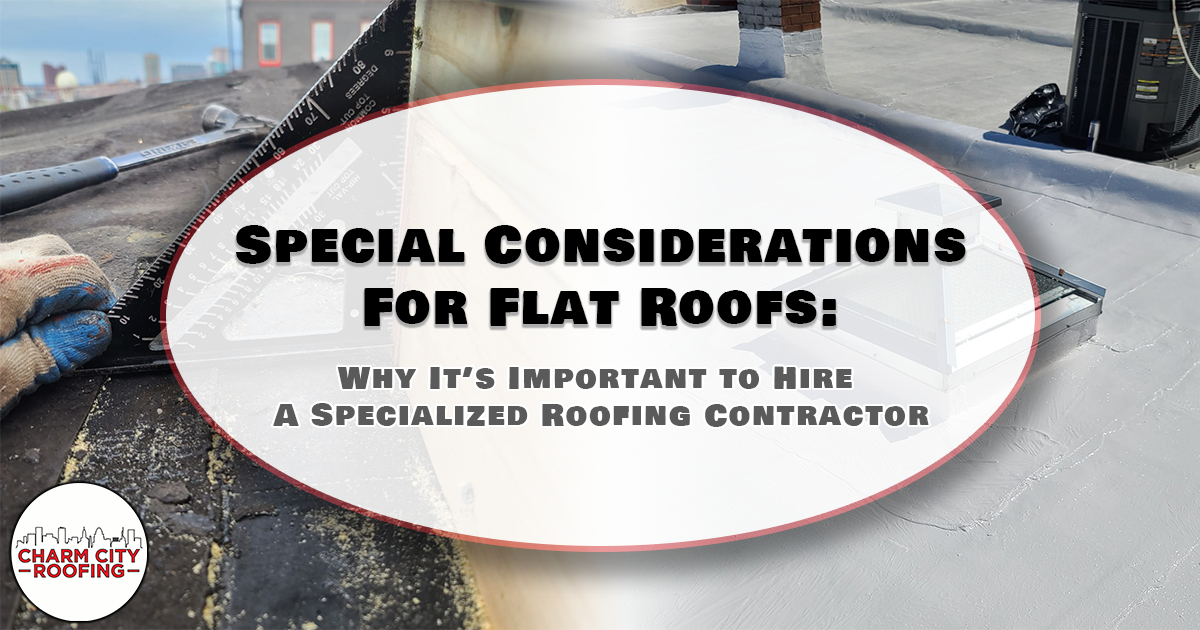
Special Considerations For Flat Roofs
Special Considerations For Flat Roofs:
Attention To Detail Is The Price Of Admission, And Experience Is Key
We’re lucky to live in a world with flat roofing. As one of the most innovative roofing developments of modern times, flat roofs offer a host of benefits that their traditional, pitched-slope counterparts do not. For example, flat roofs offer more air conditioned living space than their sloped counterparts, height for height. They can easily accommodate rooftop decks, gardens, and other usable outdoor spaces. Flat roofs are far easier to access and service. Perhaps most importantly, building and maintaining flat roofs is incredibly cost effective.
Although a new roof can be an expensive undertaking, a flat roof can be up to 38% cheaper than a pitched roof, accounting for materials and size. Flat roofs, however, are surprisingly technical in many aspects of their construction. Finding a specialist who can properly assess and repair a flat roofed building is critically important. Because of the more complex systems used in a flat roof, contractor experience can be a major factor in the roof’s end quality. Knowing the relevant challenges and considerations flat roofing involves is an asset that will serve you and your contractor well going forward.
What Makes Flat Roofs Different Than Other Roofs?
Water runs downhill. It’s a simple observation, but it also defines the cornerstone of (good) roofing. Pitched roofs let gravity do the hard work, but the flatter the roof, the more water stays on it. No one wants a puddle of standing water on their roof damaging the construction, contributing to mold and just waiting to spring a leak into the home itself. To avoid this problem, flat roofs rely on a system of carefully constructed drainage channels and gutters. When built correctly, a slight gradient in the construction will funnel water off the roof and down to ground level. These considerations take precise assessments and careful work. Often something as small as a lip between asphalt sheets or an improperly planed section will compromise the entire roof. Any mistake or miscalculation in the roof’s gradient can leave you with an improper drainage system. This will mean more frequent reroofing, additional repair work, and a bigger headache for everyone.
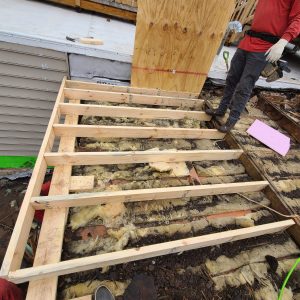
The Charm City Roofing Crew Re-planes a flat roof frame structure.
Building Structure & Frame Considerations
Furthermore, the roof itself must rest atop a properly framed structure. If the framing of the building isn’t plumb (perfectly vertical), then the water won’t flow off the roof as desired. Without a knowledgeable eye, framing issues can go undetected in the early stages of repair planning. (Regular roof inspections and assessments are invaluable in this regard.) Improper measurement, construction, or flashing is a recipe for persistent and hard-to-treat leaks. These result in damage to your home and lead to more expensive and time-consuming repairs later on. Hiring a contractor with knowledge of these issues and how to assess them is crucial. It will ensure that your roof remains strong and healthy for years to come.
Features, Components, and Details
Additional features of the roof itself also play an important role in its efficacy. It’s necessary to properly flash and seal any chimneys, exhaust fans, or HVAC units . Contractors must also pay careful attention to dormer windows and skylights, which may also create weak points in the roof. These areas are prone to leaks and trapping water, and must be attentively treated. Gutters must be properly attached and placed correctly to avoid water buildup. Even satellite dishes can be a consideration, depending on their construction and placement. Careful attention to these details will result in a high quality of construction and contribute to your home’s longevity.
Are There Different Considerations For Different Types of Flat Roofs?
There are two main kinds of flat roofing commonly used for residences and businesses. The application of each requires technical operations best performed by an experienced professional. Built-up roofing, or BUR, uses multiple layers of asphalt, gravel, and other materials to provide a watertight surface. While they provide fantastic UV and weather protection at an affordable cost, many materials used in BUR are hot-applied. The asphalt is partially melted with a torch to adhere it to the roofing felt and other protective layers. A careful, experienced contractor will have no problem safely dealing with the heat and harsh chemicals released by this procedure. A careless one, however, may damage the home or create a dangerous environment for themselves and others.
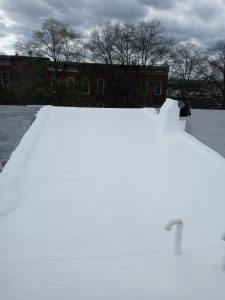
Silicone Coated Bitumin Flat Roof in Baltimore
Modified bitumen roofing is a close cousin to BUR roofing. Instead of building up layers, a roofer will roll out and adhere single- or double-ply asphalt sheets to the roof itself. Ideally, this provides a protective weatherproofing that lasts for years. These sheets, like the layers in BUR, are often heat-applied. As such, an inexperienced roofer will run many of the same risks as they would using BUR. Depending on factors like the time of year, some bitumen roofs may use an adhesive-based application method. While this eliminates many of the dangers of heat-based application, an inexperienced roofer can still apply the adhesive poorly. It’s important to ensure maximum contact between the asphalt sheet and the bitumen adhesive when applying. Failure to remove air trapped under the sheet, or improper placement of the sheet, can lead to leaks and damage.
The Bottom Line
As always, understanding the factors at play in your roofing project can yield dividends for you and your home. Because of the shallow slope of flat roofs, attention to the smallest details is essential. Basic knowledge of the technical aspects of flat roofing specifically will ensure that you don’t overlook or shortchange this critical task. They say the tongue of experience utters the most truth, and in this case we certainly agree. Make sure you put a quality roofer in charge of the flat roof you’re looking to repair or build.
Author: Wilden McIntosh-Round

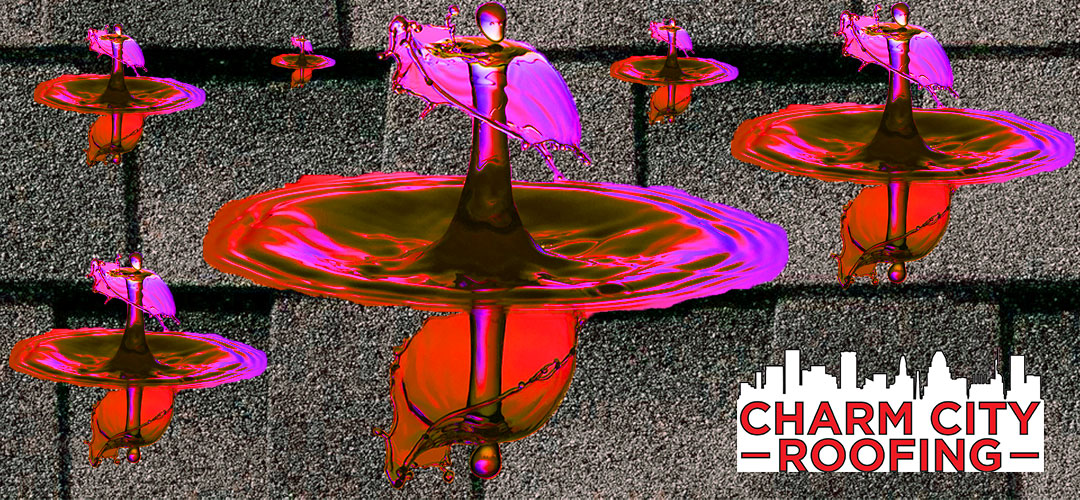

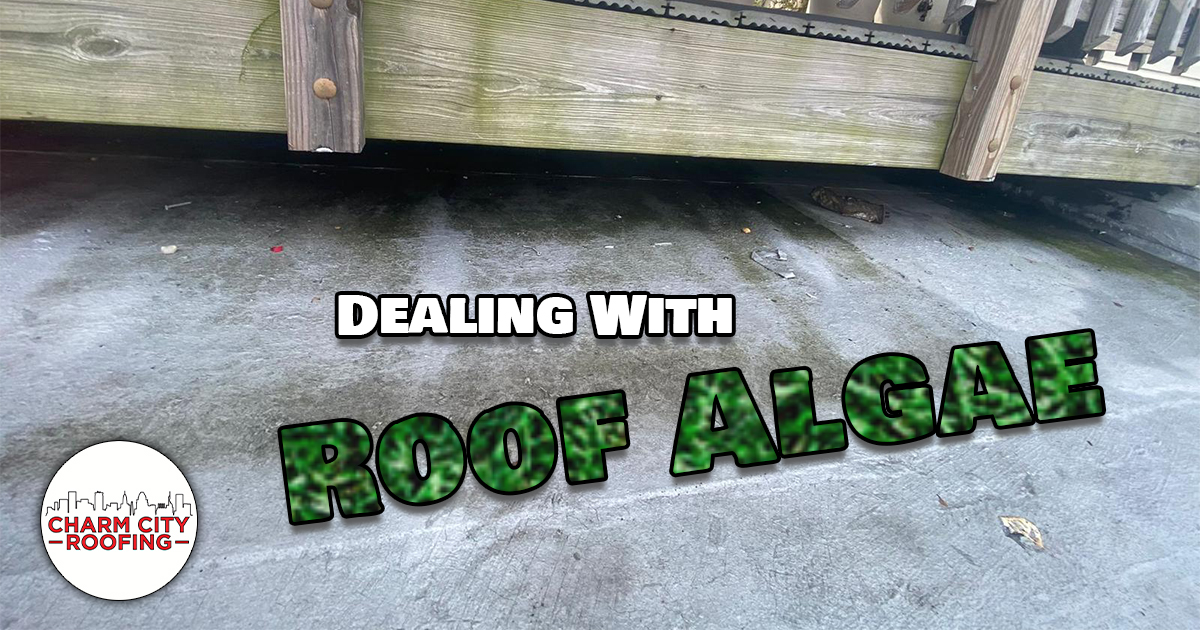
It’s awesome that this article talked about making sure the flat roof you’re planning to repair or install is in the hands of a reputable roofer. I’m glad that you explain it thoroughly and now it makes more sense. You did a great job of explaining the flat roof.
It really helped when you said that additional features on the roof can help with ensuring that it is efficient. I will share this tip with my husband so that he would decide with the help of professionals regarding flat roofing systems for our property. He just wanted to have a modern-looking home that would be durable and functional at the same time.
You have clearly outlined every point. Thank you for sharing! I look forward to checking out your blog as well.
You made an interesting point when you talked about how the application of flat roofs is best when performed by a professional. I would think that flat roofs are convenient because they would allow business owners to place things like HVAC units on the top of the building. This seems like a good way for business owners to optimize their space.
My friend wants to get a flat roof installed for his business. It makes sense that he might want to get a professional to help out with that! I can see how flat roofs would be a lot more beneficial in the long run.
Although building flat roofs is incredibly cost effective, it is important to remember to maintain them since standing water may often pose a problem. The application of a rubber roof coating will solve this problem. Butyl Liquid Rubber is a one coat application that will take standing water 365 days a year. It water proofs within a couple of hours after application. Once cured it will form a seamless membrane. It is ASTM tested and Energy Star approved.
It’s very helpful to know how accurate and precise a flat roof’s installation process must be to prevent mold or water damage in the future. My brother is building his house from scratch, and I think he wanted a flat roof for his design, so I’ll email your article to him right away. I appreciate your advice on working with professionals when installing a flat roof since it needs a carefully built drainage system.
Thanks for sharing these valuable insights about Flat roofing. Flat roofs are an ancient form of roofing. It is primarily used in arid climates. That also allows the roof space to be used as a living space. Considering these benefits, I will always prefer to go with flat roofing.